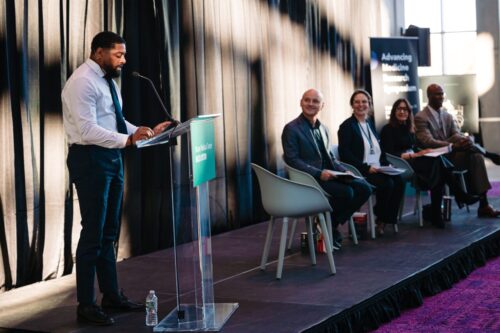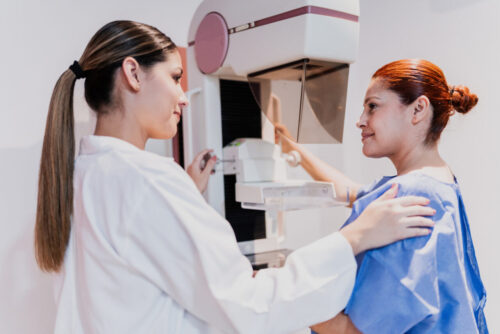Culturally Competent Healthcare: Lessons from a Safety-Net Hospital in the COVID Era
May 12, 2020
By Meryl Bailey

Getty Images
In the wake of COVID-19 lockdowns and care transformations, culturally competent approaches to care are more necessary than ever.
The COVID-19 pandemic is throwing into sharp relief how blanket approaches to healthcare are largely ineffective in reaching vulnerable populations who cannot socially distance or quarantine. Racial disparities have become a central talking point in the national conversation about COVID-19. However, communities of color are only one of many populations disproportionately impacted by this national health emergency. The elderly, people with disabilities, and people who are homeless or economically disadvantaged are more likely to suffer adverse outcomes. Addressing the root causes of health inequities is the long-term solution to changing the corollaries to health outcomes. But in a crisis, healthcare workers must act nimbly with the tools they already have at hand.
Cultural competency is one such powerful tool. The concept goes well beyond race and ethnicity to encompass empathy, curiosity, and respect for all aspects that shape a patient’s lived experience, such as age, gender identity, sexual orientation, language, housing status, value system, and more. In that way, providing culturally competent care is a lot like adjusting a recipe to appeal to an individual’s taste, and it can instill trust in the provider relationship and make healthcare messages and interventions more effective.
Successes and gaps in culturally competent care during this national health crisis are informing programs on how they can pivot their approach to care and better protect the health and well-being of their patients. Safety net hospitals are particularly adept at tailoring care models to meet the needs of diverse patient populations, and should set the example as health systems look for ways to fill the gaps in culturally competent care models.
Homelessness: “Beyond traditional cultural competence”
It has become clear that people who are homeless or housing insecure are particularly vulnerable during the COVID-19 pandemic. The transient nature of this population, coupled with limited access to hygiene facilities and exposure to crowded shelter settings, makes adhering to the standard public health guidelines around coronavirus impossible. A culturally competent care system needs to factor in the unique needs or limitations of the group.
At Boston Medical Center (BMC), the largest safety net hospital in New England, about 25% of patients admitted to the hospital are homeless. As COVID-19 became an increasing threat to Massachusetts, healthcare advocates at the hospital quickly understood the specific barriers to safety and care that would confront this portion of their population and took swift action to adapt — the new respite facility at East Newton Pavilion that was established helps fill a desperate need for quarantine space during recovery from infection.
Many in the homeless population also struggle with substance use disorder, and understanding this piece is important to providing culturally competent care. Glory Ruiz, director of public health programs at BMC, explains the challenge in tailoring public health messages around social distancing, which are in direct opposition of safety practices that help protect people immersed in street culture.
“The message that we have been giving people who are actively using drugs on the street has been to stay in groups, take care of each other, have a buddy in case you have a bad trip. The COVID messages around social distancing precautions have been completely contradictory to this message of unity,” explains Ruiz. “We have to adapt our education for patients on the street by getting the message out there about how people can protect themselves in their own context.”
Related read: Social distancing may increase HIV and overdose for at-risk groups »
She reiterates the importance of expanding the understood definition of cultural competence: “Working with homeless people, people who are actively using drugs, people who are doing transactional sex work — that goes beyond the traditional concept of cultural competence.”
Domestic violence: “Never make assumptions”
Joanne Timmons, director of the Domestic Violence Program at BMC, had to make a tidal shift in her outreach approach when Massachusetts locked down in response to COVID-19. Like many others, the program moved to a virtual office presence, but staff are available around the clock to field calls from survivors struggling with an abusive partner.
The pandemic has touched nearly every aspect of the care provided by the outreach team. Fear around contracting the virus has made many domestic violence survivors resistant to entering shelter settings, and many shelters have stopped accepting new intakes to better protect their current residents. Timmons has also seen the chaos of COVID-19 turned into a psychological weapon used by abusers to assert control over their victims, who have lost all other external support systems because of quarantine.
“Now people are afraid to go out or afraid to take the subway, afraid to go to the grocery store. So it is this big perfect storm of financial insecurity and also fear related to health. These are fears we all are experiencing, but then there is the additional layer of fear if there’s somebody that is threatening or abusing you in some way that limits your options even more,” she explains. Understanding these nuances can help avoid situations in which the provider offers help that is anything but helpful.
As the complexity of cases has increased, advocates at BMC are tailoring their outreach case by case. The Domestic Violence Program has been offering more assistance to survivors who are fearful of contracting the virus, providing basic needs such as food and transportation to shelters or critical medical appointments. Providing culturally competent care in this setting means never making assumptions about a person’s living situation: Will the person have access to make a phone call? Do they have privacy? Do they have access to technology to seek restraining orders or continue custody battles?
“We can never assume we know what somebody means if we don’t ask them. We should always be asking, ‘What do you mean by that?’ or ‘Why does that concern you?’ When it comes to COVID-19, we never make assumptions that people know what is safe. A partner could be telling a patient that they can’t go out of the house, for example, but that’s not technically true,” explains Timmons.
Limited English proficiency: “We don’t convey words. We convey meaning”
Interpreter services at Boston Medical Center has been working around the clock over the past eight weeks to translate COVID-19 health information for the 30% of BMC patients who have limited English proficiency (LEP). Reaching these patients in their households, many who reside in COVID hot spots, is crucial to helping to slow the spread of the virus.
“When we interpret, we don’t convey words — we convey meaning. We convey the nuances, the tone of voice. We identify the gaps in communication,” explains Alegna Zavatti, the director of interpreter services at Boston Medical Center. “All of these things need to be communicated in a way that accounts for people’s cultural codes.”
But truly effective interpretation requires face-to-face interaction with patients, says Zavatti. “If you see the person’s face, you immediately know what they’re saying without even speaking.”
With in-person communication limited in the face of coronavirus, the obvious solution is telehealth. But as a blanket solution, it leaves some important groups behind. For example, health professionals are finding it challenging to provide video conferencing in Latino households where interpreters are needed for reasons beyond interpretation alone.
“We have a lot of patients with LEP who don’t want to participate in video telehealth. We have video capabilities, but there’s a cultural aspect particular to the Latino community where you need to look your best, always,” explains Ruiz. “The patient thinks, ‘My house is a mess and I’m in my PJs, and the doctor wants to see me? No, I don’t want that.’ It is a cultural barrier.”
Beyond cultural barriers, these households are also more likely to face limited access to internet and phone service. Providers are continuing to strategize on how to best provide remote care to this community.
“For example, when you’re talking about healthcare disparities, we know that blacks and Latinos are disproportionately impacted by diabetes. Nutrition is a crucial part of prevention. But it’s also about knowing what foods are appealing in the culture, and that can be hugely impactful. It will resonate, the patient will feel heard and understood, and they will be more likely to engage with that care provider,” says Ruiz.


